What is Furniture Design
Furniture design is about making stuff that’s both practical and looks good. Over time, it’s evolved from basic pieces to intricate designs influenced by eras like ancient times, the Renaissance, and modernism. With the Industrial Revolution, furniture became more accessible thanks to mass production techniques. Then came sleek and simple modernism, followed by the funky shapes of mid-century modern. Now, postmodernism has brought a mix of styles, and contemporary design focuses on diversity and sustainability.

Importance of Furniture Design timeline creation for a designer
Creating a timeline for furniture design is vital for designers as it aids in project management by breaking down tasks and allocating resources efficiently. It facilitates client communication, manages expectations, and fosters transparency. Timelines also enable iterative design processes, and quality control, and help designers stay competitive in the market. Additionally, they provide adaptability to unforeseen changes while ensuring timely project completion.
Table of Contents
Neolithic Period : ( 3100-2500 BC)
Archaeological exploration at Skara Brae, Orkney, unearthed a fascinating glimpse into ancient furniture practices dating back to 3100-2500 BC. In this remote region, where timber was scarce, the ingenious inhabitants turned to the abundant stone resources around them. With creativity born out of necessity, they crafted a remarkable array of stone furniture, showcasing their mastery of local materials. This ancient community ingeniously fashioned stone into functional household items, demonstrating resourcefulness and adaptability in their daily lives.
Key Features to Look at: In the Neolithic Period, furniture design primarily evolved in a functional and utilitarian style focused on meeting the practical needs of early agricultural societies.
Wooden furniture: Simple, wooden furniture crafted for practical use.
Functionality: Furniture served essential functions like seating and storage.
Stone tools: Crafted using basic stone tools like axes and adzes.
Archaeological evidence: Discoveries like benches at sites such as Çatalhöyük.
Cultural significance: Reflecting societal values and beliefs of Neolithic communities.

Neolithic Period Furniture
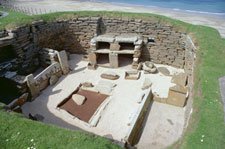
Neolithic House,(The transition from a nomadic society, dependent on hunting and gathering, to an agricultural)
Ancient Egyptian: Roughly from 3100 BC to 332 BC
Ancient Egyptians, from Ancient Egypt, known for their impressive pyramids and intricate art, also designed and crafted functional and sophisticated furniture design.
Key Features to Look at:
Materials: Wood, stone, metal, reeds, palm leaves.
Style: Simple, geometric, minimal ornamentation.
Functionality: Chairs, stools, beds, tables, chests, thrones.
Decoration: Hieroglyphs, patterns, animal motifs.
Social Significance: Status symbol, elaborate pieces for royalty/elites.
Common Types: Stools, chairs, beds, tables, chests, thrones.
Uniqueness: Durable, symbolic, connects to architecture.
Examples: Tutankhamun’s Throne,
duck-head stool, and decorated chests.
Modern Appeal: Functional, durable, geometric forms.


Chest-from-tomb-of-prince-Khaemwaset

QueenHetepheres-bed-replica-boston-museum-art
Ancient Greek Period
Geometric Period (1100-750 BC):
Furniture was limited due to the Bronze Age focus on pottery and metalwork. Chests, stools, and small tables were basic and geometrically decorated.
Archaic Period (750-480 BC):
The emergence of more diverse furniture types like klinai (couches), thrones, chairs, and tables. The use of animal-shaped legs and bronze adornments increases.
Classical Period (480-323 BC)
Refinement and standardization of furniture design. Klinai became more elaborate, featuring armrests and cushions. Chairs with intricate backrests and curved legs appear. They Emphasis on comfort and proportion.
Hellenistic Period (323-146 BC):
Furniture designs become more lavish and diverse, influenced by foreign cultures. Marble and ivory join wood and bronze. Intricate inlay work and elaborate carving became popular.
Ancient Greek Period Key Features
Klinai: Reclining couches used for dining, socializing, and sleeping.
Thrones: Elaborate chairs reserved for high-ranking officials and deities.
Chairs: Varied designs, from simple stools to comfortable chairs with
backrests.
Tables: Used for dining, writing, and games. Often had three legs and
were made of wood or marble.
Chests: Used for storage and seating. Decorated with geometric
patterns and mythological scenes.
Beds: Simple wooden frames with straw mattresses. Later periods saw
more elaborate designs with headboards and footboards.
Footstools: Used for comfort and status. It is Often depicted in art and archaeology.

Medieval Furniture
Medieval Furniture(roughly from the 5th to 15th centuries AD):Evolution: Evolved through the period: * Early Middle Ages (500-1000 AD):
Simpler,cruder pieces reflecting limited resources andstability.
* High Middle Ages (1000-1300 AD):
Increased prosperity led to more refined designs and complex joinery.
* Late Middle Ages (1300-1500 AD):
In this Furniture design era, there was Great emphasis on comfort and decoration, with influences from Gothic architecture and international trade.
Medieval Furniture Period Key Features
Style: Evolved from basic to ornate, featuring:
- Heavy chests for storage.
Sturdy tables for dining and work.
High-backed chairs for comfort and status.
Wood and iron construction, often adorned with carvings and textiles.
Functionality: Primarily focused on function
over aesthetics, catering to the practical
needs of daily life.
Materials: Mainly wood (oak, pine, etc.) and iron, with limited use of other materials like leather and textiles for padding and decoration.
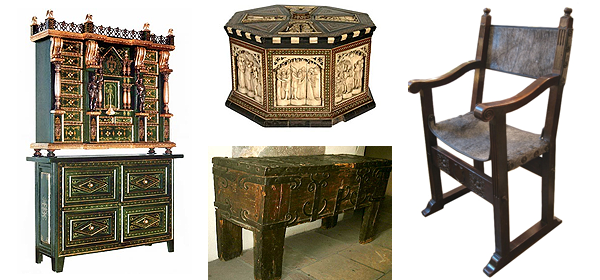

The Glastonbury Chair
Decoration: Carvings, paintings, and metalwork embellishments, often featuring religious motifs, geometric patterns, and heraldic symbols.
Social Significance: Furniture reflected social status and wealth, with elaborately crafted pieces owned by nobility and clergy.

The Coronation Chair
Modern Influence: The use of chest-like storage pieces, heavy wooden tables, and high-backed chairs continues to inspire contemporary furniture design.
Renaissance Furniture: 14th-16th centuries
The Renaissance brought a revival of interest in classical forms and a surge in artistic expression reflected beautifully in furniture design.
Key Features to Look at:
Style:Inspired by ancient Greece and Rome, with an emphasis on:
- Harmony and proportion
- Classical motifs and decoration.
- Rich materials and craftsmanship.
Cabinets/chests: Elaborate carvings, often mythological or geometric.
Tables: Rectangular/folding, intricate legs & inlaid decoration.
Chairs: More comfortable, upholstered seats/backs.
Beds: Grand & imposing, with canopies & intricate headboards.
Desks: Designed for writing/studying,with drawers & compartments
Materials:
Wood: Walnut, oak, etc., often inlaid with ivory or precious metals.
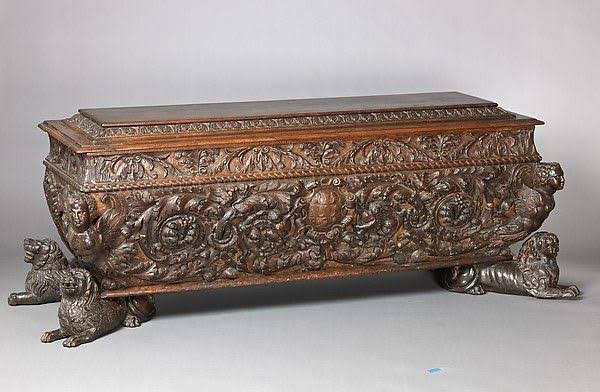
Cassone: Elaborately decorated chest or marriage chest.

Savonarola chair: Simple, functional chair with X-shaped back.

Trifid table motifsrenaissance furniture.
Metals: Bronze, iron, silver for accents & hardware.
Textiles: V elvet, silk, brocade for upholstery & bed hangings.
Impact: Established foundation for modern furniture design Introduced new techniques & materials Reflected cultural & artistic spirit of the Renaissance.
Jacobean Furniture :1603-1625 (England)
The Jacobean era of furniture design was a period of great change in England, both politically and culturally.
Material: Oak (dominant), with occasional lime, cherry, or exotic woods
Style:
Massive & imposing: Built for stability and showcasing wealth.
Geometric & classical: Inspired by Italian Renaissance, infused with Elizabethan flair.
Richly carved: Scrolls, lozenges, arches, floral & other motifs.
Straight lines & symmetry: Rectangular seats, perpendicular legs.
Emerging features: Gate-leg tables, chests of drawers, built-in furniture.
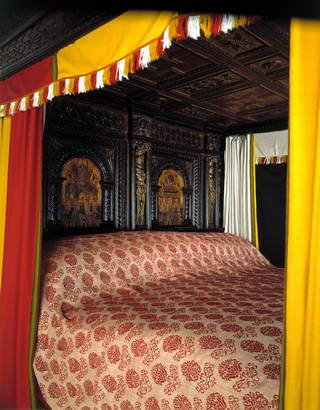
Great Bed of Ware

Sutton Hoo Ship furniture

Ham House Gatehouse Table
Colonial furniture: 17th - early 19th century
The Jacobean era was a period of great change in England, both politically and culturally.
Materials:Dominant: Furniture design with Wood (local varieties like maple, pine, cherry) was vastly seen.
Occasional: Walnut, and mahogany (imported, more valuable) were used mainly in that furniture design period.
Style: Functional & sturdy: Built for everyday use, often by hand.
Simple & clean lines: Minimal ornamentation, geometric shapes.
Influences: European styles like Queen Anne, Chippendale, mixed with local traditions.
Key features:
Turned legs: Straight or tapered, sometimes with stretchers.
Dovetail joints: Strong, visible craftsmanship
Brass hardware: Accents, hinges, drawer pulls.
Upholstery: Simple fabrics (wool, linen) for comfort.
Regional variations: Q ueen Anne influence in New England, Dutch elements in Mid-Atlantic, Spanish in Southwest.

Windsor chair

Gate-leg table, Colonial furniture

Shaker furniture
Rococo Furniture
8th century, furniture design originated in France (1730s) and spread across Europe.
Style (Light & playful): The furniture design styles in this Era were the contrast of the grand, formal Baroque style.
Curvy lines & asymmetry: Think “S” and “C” shapes, creating a dynamic flow.
Ornate decoration: Gilded bronze mounts, floral motifs, shellwork.
Luxury materials: Rich woods (mahogany, rosewood), gilt, porcelain.
Emphasis on comfort: Upholstered seating, cabriole legs were the main focus point in this furniture design period.
Key features:
Cabriolet legs: Gracefully curved with outward-facing knees.
Bombe chests: Rounded chests of drawers, often with marble tops.
Ormolu mounts: Elaborate gilt-bronze decorations.
Marquetry: Decorative inlaid wood patterns.
Pastel colours: Soft hues like cream, pale blue, lilac.
Mythological & natural motifs: Shells, animals, flowers.

Bureau du Roi: Louis XV’s writing desk, a masterpiece of Rococo craftsmanship.

Fauteuil en cabriolet: A classic Rococo armchair with cabriole legs and flowing lines.

The common Furniture leg design called Cabriolet legs.
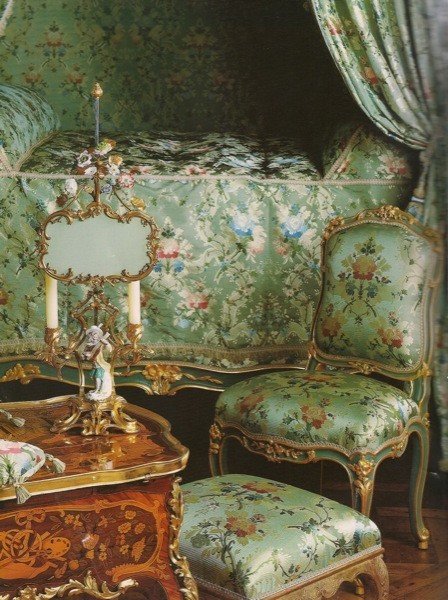
Commode de Madame de Pompadour: A luxurious chest of drawers designed for the famous royal mistress.
Revival Furniture:
Various, depending on the specific revival style (broadly, 18th – early 20th century).
Key Features:
Hybrid nature: Blends feature design from previous eras (e.g., Gothic, Renaissance, Rococo) with modern touches.
Variety of styles: Gothic Revival, Neoclassical, Rococo Revival, etc., each with unique details.
Rich materials: Often uses high-quality wood (mahogany, walnut), sometimes with metal accents or upholstery.
Ornate details: These can include carvings, mouldings, and marquetry, depending on the revival style.
Focus on craftsmanship: Often hand-crafted, emphasizing quality and intricate work.


Gothic Revival: Pointed arches, stained glass, dark woods.

Neoclassical: Straight lines, symmetry, Grecian motifs.
Art Nouveau Furniture
Late 19th & early 20th centuries (1890s – 1910s), primarily in Europe.
Features: Art Nouveau Furniture created in the Art Nouveau style was prominent from the beginning of the 1890s to the beginning of the First World War in 1914.
Style: Organic & flowing: Inspired by nature, featuring curved lines, whiplash forms, and asymmetry.
Emphasis on craftsmanship: Hand-crafted pieces often incorporate innovative techniques like metalwork and glass.
Symbolism & allegory: Motifs like flowers, insects, and female figures hold deeper meanings.
Luxury materials: Rich woods (oak, mahogany), stained glass, wrought iron, enamel.
Integration of arts: Blurring the lines between furniture, sculpture, and decorative art.
Key Feature: Whiplash curves: Flowing lines inspired by plant stems and organic forms.
Floral & insect motifs: Lilies, orchids, dragonflies, and butterflies incorporated into designs.
Stained glass panels: Often used for doors, cabinet inserts, and lampshades.
Wrought iron accents: Ornamental details with swirling patterns and vegetal forms.
Mosaics & enamelwork: Decorative accents adding colour and texture.
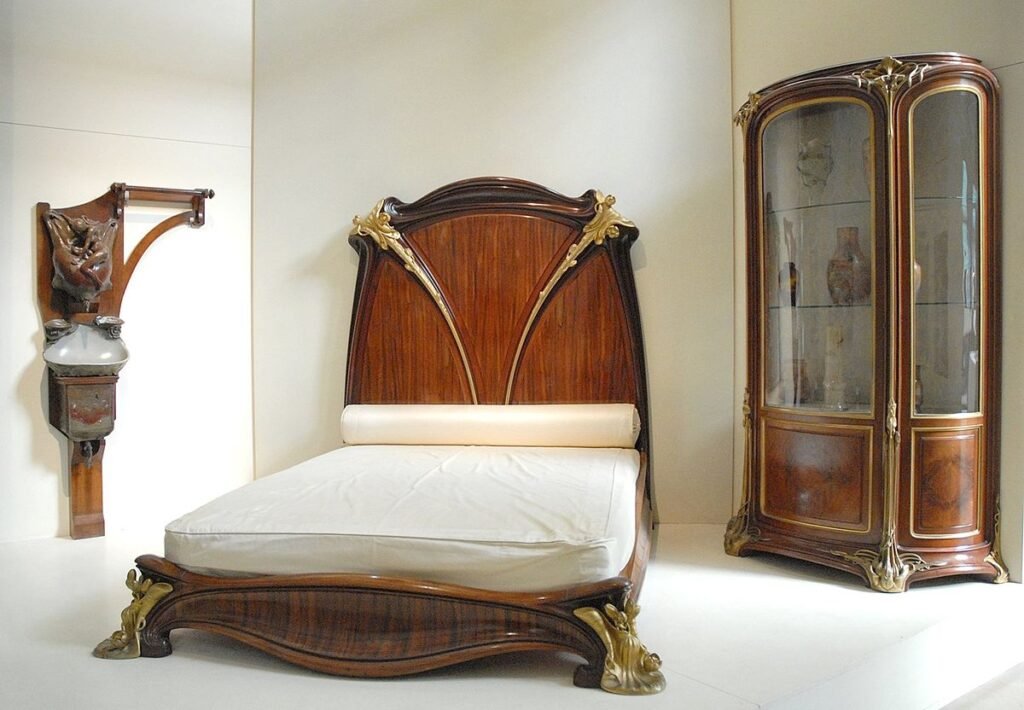
Water Lily bedroom set by Louis Majorelle (1902-1903)

Mahogany chair by Victor Horta (1900) (Cleveland Museum of Art)
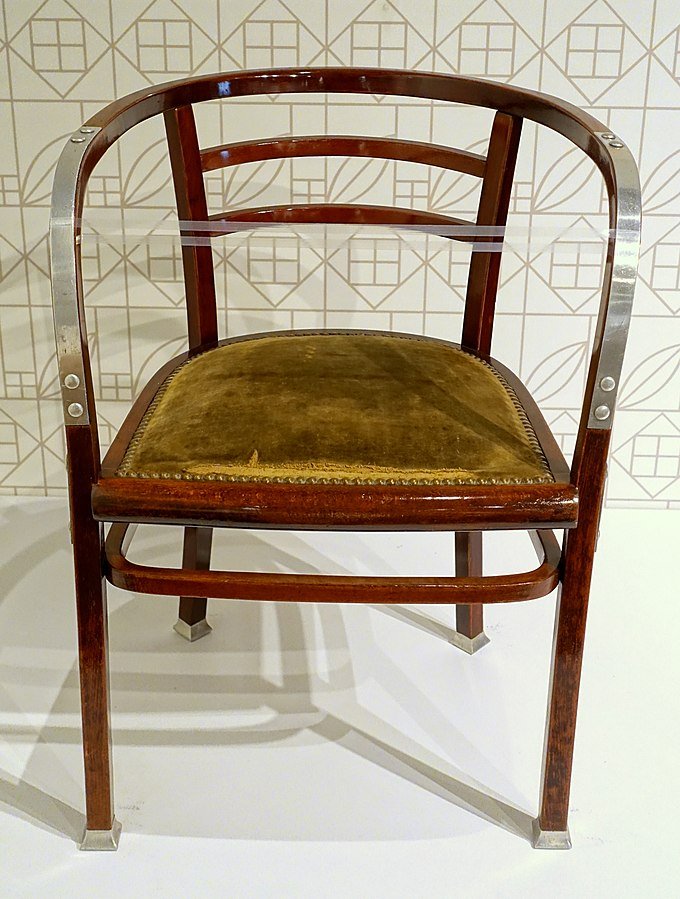
beechwood, cane and aluminium armchair by Otto Wagner (1905–1906)

Bedroom furniture of the Hotel Guimard by Hector Guimard (now in the Musée des Beaux-Arts de Lyon)
Bauhaus Furniture
1919-1933 (Germany): The term “Bauhaus” predates its association with furniture design and stems
from the school itself – the Staatliches Bauhaus (State Bauhaus) established in Germany in 1919.
The founder, Walter Gropius, intended the school to encompass all aspects of design, hence the
name “Bauhaus,” which comes from inverting the German word “Hausbau” (“building house”).
While the school initially focused on architecture and crafts, furniture design became a prominent
aspect throughout its existence. This led to an association of the “Bauhaus” term with the distinctive
furniture design style emerging from the school’s principles and teachings.
Renowned designers like Marcel Breuer, Mies van der Rohe, and Marianne Brandt developed iconic furniture pieces during their time at Bauhaus, solidifying the association between the term and the
specific design style.
Style: Form follows function: Prioritizing practical use over unnecessary ornamentation.
Modern & minimalist: Clean lines, geometric shapes, and uncluttered design.
Emphasis on materials: Chrome, steel, glass, and sometimes wood, showcasing functionality and beauty.
Mass production: Designed for easy manufacturing and affordability.
Collaboration & Innovation: Merging craft and industry, prioritizing experimentation and new materials.
Key Feature:
Cantilever chairs: No rear legs, suspended for comfort and visual lightness.
Tubular steel frames: Strong, lightweight, and visually modern.
Flat roofs & smooth surfaces: Reflecting the minimalist aesthetic.
Chrome & nickel accents: Adding sleekness and shine.
Built-in furniture: Maximizing space and promoting efficiency.

Bauhaus furniture tubular steel frames.

Baby Cradle by Peter Keler,Kandinsky’s work was the inspiration for German architect Peter Keler’s Baby Cradle, which he designed for the first Bauhaus exhibition in the Haus am Horn in Weimar in 1923.

Cantilever Chair – Marcel Breuer.
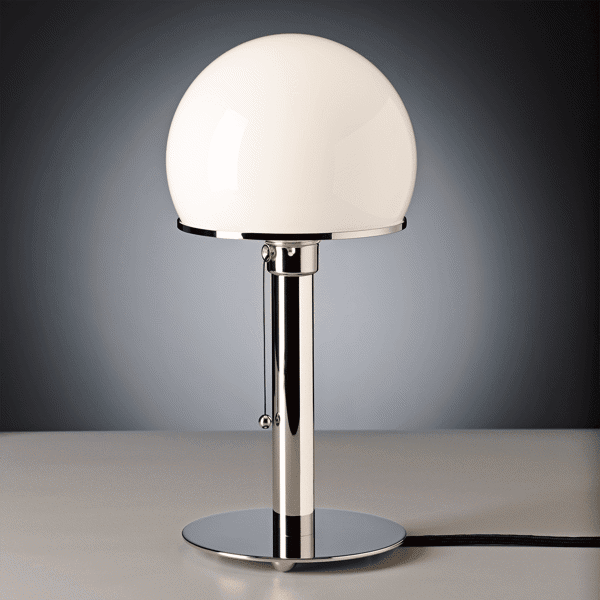
Lamps by Wilhelm Wagenfeld.

Bauhaus-Barcelona-chair- crop-v2,builtin furniture.

Nesting Tables by Josef Albers.
Art Deco Furniture: 1920s - 1930s (primarily)
Style: Glamorous & luxurious: Art Deco Reflecting the Jazz Age spirit, often using expensive materials and bold colours.
Geometric & streamlined: Inspired by Art Deco architecture, featuring symmetrical shapes, chevrons, sunbursts, and zigzags.
Exotic influences: Drawing inspiration from ancient Egyptian, Aztec, and other cultures.
High-quality craftsmanship: Utilizing expensive distinctive rounded shape.
woods, metals, glass, and lacquer.
Integration of art & design: Blurring the lines between furniture and sculpture, featuring decorative motifs and textures.
Key Feature: Inlays & marquetry: In this Era of furniture design wood was used, ivory, or metal to create geometric patterns.
Chrome & nickel accents: Adding shine and a modern touch.
Animal motifs: Stylized depictions of animals like
gazelles, leopards, and swans.
Sunburst & geometric patterns: Prominent across legs, headboards, and upholstery.
Rich fabrics & leathers: Velvet, satin, and crocodile skin for luxury and comfort.
High-gloss finishes: Lacquered wood or polished chrome for a glamorous look.

Eileen Gray’s “Bibendum” chair: An upholstered armchair with adistinctive rounded shape.

Emile-Jacques Ruhlmann’s “Grand Palais desk”: A luxurious desk with chrome accents and exotic wood inlays.

Jacques-Emile Ruhlmann’s “Amorphous” armchair: A sculptural armchair with flowing lines and luxurious upholstery.
Modern Furniture
Not a single era, but a broad term encompassing various design movements from the mid-20th century onwards.
Style: Clean lines & minimalist: In furniture design, this Era emphasises on simplicity and functionality, eliminating unnecessary ornamentation.
Innovative materials: Exploring new materials like moulded plywood, plastics, and metals.
Form follows function: Design prioritizes usability over aesthetics.
Neutral colour palettes: Often favouring blacks, whites, and earth tones.
Open & airy spaces: Furniture design promotes uncluttered and spacious environments.
Key Feature: Geometric shapes.
Cantilevered chairs: Seats supported by single legs or beams, creating a light and airy feel.
Tubular steel frames: Strong and lightweight, showcasing industrial materials.
Modular furniture: Adaptable pieces that can be Ensuring comfort and support through thoughtful design.
Focus on ergonomics: Ensuring comfort and support through thoughtful design.
Eames Lounge Chair by Charles and Ray Eames: Comfortable and iconic moulded plywood chair.

Noguchi Coffee Table by Isamu Noguchi: This organic-shaped coffee table combines wood and glass to create a unique and sculptural piece of furniture.

Le Corbusier LC2 Sofa: This minimalist and timeless sofa features a chrome-plated steel frame and loose cushions, exemplifying the principles of form following function.
Conclution
In conclusion, exploring the diverse periods of furniture design history offers us a rich tapestry of design evolution and human creativity. Here are the key points addressed in the conclusion:
- Reflection on the diversity of furniture history across various periods.
- Recognition of the impact of societal changes, technological advancements, and cultural influences on furniture design.
- Appreciation for the craftsmanship, innovation, and ingenuity evident throughout furniture history.
- Acknowledgement of the enduring quest for beauty, functionality, and expression in furniture design.
- Encouragement to draw inspiration from the past while embracing the possibilities of the future to ensure the ongoing evolution of furniture design.
FAQ
Q: What makes every furniture period novel?
A: Furniture styles shift given social, mechanical, and creative patterns, with Old Egyptians esteeming common sense and imagery, and the Extravagant time frame embracing lavish designs and polish.
Q: How did individuals in antiquated human advancements like the Old Greeks and Egyptians use furniture?
A: Furniture in old developments filled both viable and emblematic needs. Old Greeks involved furniture for eating, relaxing, and get-togethers, while Old Egyptians accepted furniture had otherworldly importance and involved it in entombments and day-to-day existence.
Q: Which job did craftsmanship play in the archaic furniture plan?
A: Craftsmanship was vital to the middle age furniture plans, with craftsmen utilizing unpredictable carvings and joinery strategies to make resplendent pieces frequently including strict imagery. Each piece was fastidiously created the hard way, mirroring the commitment and ability of the skilled workers.
Q: How did the Bauhaus development impact the furniture plan?
A: The Bauhaus development reformed furniture configuration by stressing functionalism, effortlessness, and large-scale manufacturing. Bauhaus creators tried to consolidate workmanship and industry, making smoothed-out furniture that focused on structure following capability standards and moderate style.
Q: What characterizes the present-day furniture plan?
A: Cutting-edge furniture configuration is portrayed by clean lines, effortlessness, and an emphasis on usefulness. Fashioners in the cutting-edge period explored different avenues regarding new materials and assembling procedures, making famous pieces that are as yet compelling today.
Q: How did pilgrim furniture reflect social impacts?
A: Pilgrim furniture mirrored a mix of European, Asian, and native impacts, adjusting styles to suit the pragmatic necessities and social inclinations of provincial pioneers. This combination brought about novel plans that are commended for their adaptability and appeal.
Q: What put Workmanship Nouveau furniture aside from different styles?
A: Craftsmanship Nouveau furniture split away from customary plan shows by embracing natural structures, streaming lines, and regular themes roused commonly. It addressed a takeoff from each style of the past, zeroing in rather on imaginative and expressive plans.
Q: For what reason are recovery periods critical in furniture history?
A: Restoration periods were the time of recharged interest in before styles and plan developments. They permitted creators to rework verifiable styles through a contemporary focal point, mixing sentimentality with present-day sensibilities and adding to the lavishness of furniture plan history.
Q: How could information on furniture periods illuminate inside plan decisions today? A: Understanding furniture periods gives an abundance of motivation to inside plans, permitting people to make exceptional and varied spaces that mirror their style and inclinations. By drawing from various periods, creators can make amicable and outwardly captivating insides that go the distance.

